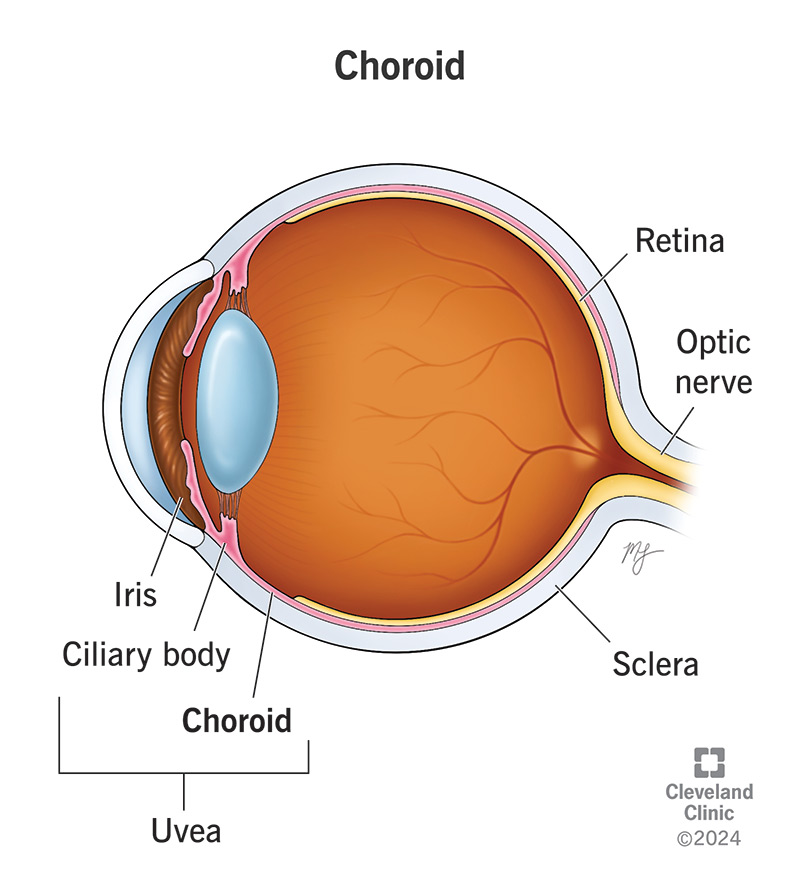Tucked away as the central/rear section of the middle layer of your eyeball’s outer wall, the choroid is one of the less visible eye structures. But while it may not be easy to see this structure, it’s essential to your sense of vision. Knowing how it works and what it needs can be important to helping maintain and protect your vision.
Advertisement
Cleveland Clinic is a non-profit academic medical center. Advertising on our site helps support our mission. We do not endorse non-Cleveland Clinic products or services. Policy

The choroid is a part of the uvea, the middle layer of your eyeball’s outer wall. It’s a key supplier of blood to some of your eyes’ most critical structures. The choroid (pronounced “KOR-oid”) also plays a role in how light acts inside your eye, making it a crucial part of how you see the world around you.
Advertisement
Cleveland Clinic is a non-profit academic medical center. Advertising on our site helps support our mission. We do not endorse non-Cleveland Clinic products or services. Policy
The choroid has two main jobs: blood supply and light absorption.
Blood supply is the choroid’s main job. In particular, it supports the retina and optic nerve. Those structures are constantly sending signals to your brain, so they have an unusually high demand for blood and nutrients compared to other eye tissues. The choroid contains layers upon layers of blood vessels, allowing it to supply the needed blood.
The choroid’s other job, light absorption, isn’t as obvious, but it’s no less important.
The choroid contains larger amounts of melanin than most other tissues in your eyes. Your body uses melanin in your skin to absorb the sun’s ultraviolet rays. That absorption limits the damage that UV rays can do to the DNA in your skin (damage that can add up and cause skin cancer). Melanin absorbs larger amounts of all visible light, too, not just UV rays.
Melanin inside your eyes works similarly to acoustic foam insulation. That foam dampens and absorbs sound waves, keeping them from bouncing and echoing. Recording studios use it to keep unwanted outside noise out and keep desirable sounds inside from being overwhelming. Likewise, melanin inside your eyes stops light from scattering so it doesn’t overload and confuse the light-sensitive photoreceptor cells in your retinas.
Advertisement
The choroid surrounds the rear two-thirds of your eyeball, sitting just underneath the eye’s white outer wall (the sclera) and just above the retina, the light-detecting layer that lines the inside rear areas of your eye. The choroid ranges from 0.1 millimeters (mm) thick — about the same thickness as standard, letter-size printer paper — to 0.22 mm thick.
The choroid is densely packed with blood vessels. It’s also darker-colored because of the melanin in it. And you can have birthmarks or freckles (nevi) on your choroid, too. These are invisible, and the only way most people learn they have them is when an eye care specialist or other provider sees these coloration differences or markings during an eye exam.
Many diseases can affect the choroid. They range from circulatory conditions to inflammatory diseases and more. They include:
Symptoms of choroid-related conditions may include:
There are also several symptoms that can indicate a more serious or emergency issue. These include:
An eye care specialist doing a routine eye exam can see changes in the choroid through the thin layers of the retina or through changes in the retina itself. There are also several tests that can help check the choroid or diagnose conditions affecting it. They include:
Retinal imaging tests can also be helpful for checking the choroid because of the circulatory connection between the choroid and retina. Examples of tests like this include fluorescein angiography, indocyanine green angiography and optical coherence tomography.
Most of the treatments that affect the choroid only work indirectly. That means treating the underlying condition affecting the choroid. And those treatments can vary widely depending on the underlying cause. Some examples include:
Advertisement
Depending on the underlying condition you have, other treatments may be likely. Your eye care specialist or another healthcare provider can tell you more about these treatments and help guide you in choosing one that works best for you.
There are several things you can do to maintain and improve your eye health, including the health of your choroid. The most important thing you can do for your choroid is to get regular eye exams. That goes for everyone, not just people who wear glasses or contacts.
Advertisement
Other steps you can take include:
Your retinas detect light and convert what they detect into huge quantities of visual signal data that they then send to your brain. They need a steady, sizable supply of blood. And your choroid is the main supplier of blood to your retina and optic nerve. Your choroid also helps your eyes manage light, making it easier for your retinas to handle the light they receive. While it may not get as much glory as other eye structures, it’s still critical. And there’s plenty you can do to care for your choroid — and overall eye — health in your everyday life.
Advertisement
Cleveland Clinic’s ophthalmologists and optometrists have the highest training available. We provide exams, vision correction and care for many eye conditions.

Last reviewed on 11/03/2024.
Learn more about the Health Library and our editorial process.